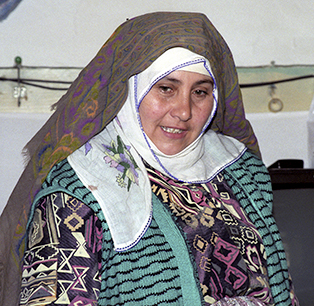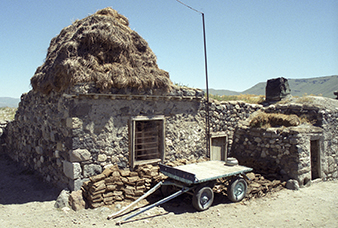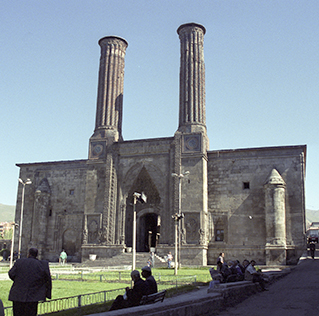Eastern Turkey
Day 4 - Thursday, 22 June 2000
Erzurum
Some Erzurum women wear a unique, one-piece garment made without a seam. The fabric is hand woven of natural colored wool, white or brown, and embroidered with tiny blue flowers. The dress is used to completely cover the woman except for her face, and she holds the face opening closed with her mouth so that all you see is her eyes. We saw several, but Meli says it is becoming more rare. "They will never give you permission to take their picture." She told us. I think it was implied, "don't ask, just take the picture and move on quickly."
The name Erzurum is derived from two words, Ars, meaning land, and rum, meaning Rome. The city of Erzurum was the gateway for people from the East into the land of the Romans.
Village Visit
We visited a home in a nearby village. We also visited a school, which is empty for the summer. But two teachers materialized, and the children ran from every direction to see these strangers in their village. They performed a musical number for us.

In the home, we learned that the 18 year old daughter is engaged to a
Turk who is living in Germany. His family has been there for 35 years, and he
works as a miner. We did not learn how they managed to meet each
other.
We visited a Seljuk museum covering the period 1071-1299. It is a synthesis of Central Asian and Anatolian cultures. The building was once a medrasa, and the entry to the rooms is through low doorways. These doorways forced the students to bend, showing respect when they entered their classrooms.

Hay is stacked on the roof so that during the harsh winter it can be
pulled down through a hole in the ceiling and fed to animals in the room
below.
The dome of the medrasa is primitive in design, but functional. The opening in the dome allowed the stars to be reflected in the pool beneath, and in this way the students could study astronomy. They also studied many other disciplines.
We visited an 800-year-old mosque, and were joined by the imam. We learn that imam means teacher, and another word for imam is "hodja." This imam has been in this mosque for 21 years and is near retirement. To be an imam, one must first complete vocational school, then he has two years of training. He also must pass a civil servant exam.
We were allowed to ask questions, and learned that the department of religion, located in Ankara, governs mosques in Turkey. The imam is paid through this department, and the subjects for his weekly sermons come from there. He does not perform weddings, as a wedding is a civil ceremony. He does the funerals, and prays for people, but is not involved in circumcision. The barber does circumcisions. The imam may be asked to contribute a prayer, but otherwise the ceremony is a family event rather than a religious event.
The imam sang the "call to prayer" for us, using the morning version. The morning version is different in that it adds the words "praying is better than sleeping."
In their schooling, we are told, they study history of all religions for two hours per week.

We visited a medrasa which is also the tomb of the woman who had it built. There are two minarets on this building. One was built by the master, and the other by his apprentice. When the apprentice realized that his minaret was better than the one built by the master, he committed suicide.
We had a snack in an old building, which has been converted to a restaurant. The rooms are divided into private dining areas, and each one is heavily carpeted and decorated with old things. It seemed an ideal place for young would-be lovers to have a tryst, or to get acquainted - or seduced.